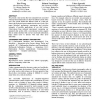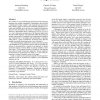180 search results - page 28 / 36 » Theory and method for experience centered design |
CHI
2008
ACM
14 years 7 months ago
2008
ACM
We performed an empirical study to investigate whether the context of interruptions makes a difference. We found that context does not make a difference but surprisingly, people c...
CHI
2004
ACM
14 years 7 months ago
2004
ACM
We present a chat system that uses animated text associated with emotional information to show the affective state of the user. The system obtains the affective state of a chat us...
ATAL
2009
Springer
14 years 1 months ago
2009
Springer
This paper presents a model of neural network embodiment of intentions and planning mechanisms for autonomous agents. The model bridges the dichotomy of symbolic and non-symbolic ...
TLDI
2010
ACM
14 years 3 months ago
2010
ACM
ML modules are a powerful language mechanism for decomposing programs into reusable components. Unfortunately, they also have a reputation for being “complex” and requiring fa...
ICIP
2002
IEEE
14 years 8 months ago
2002
IEEE
Digital fingerprinting is an effective method to identify users who might try to redistribute multimedia content, such as images and video. These fingerprints are typically embedd...


